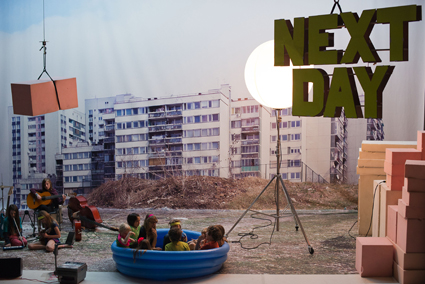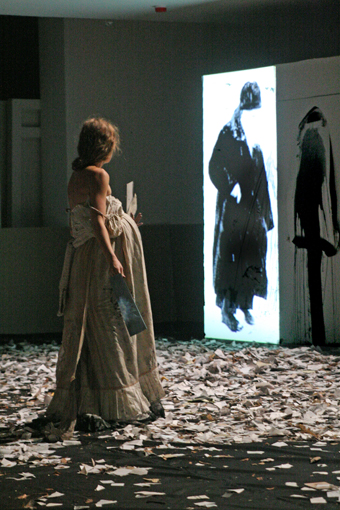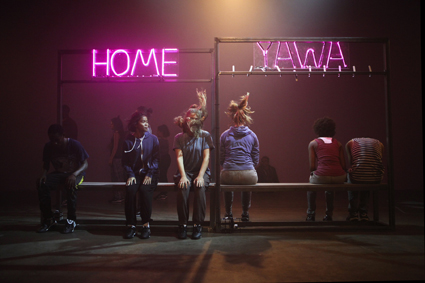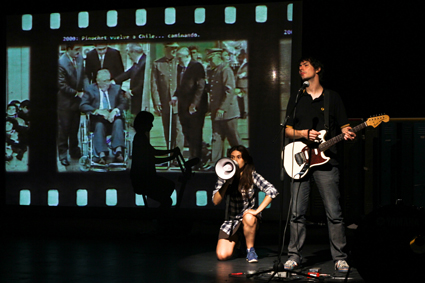 |
Next Day, Philippe Quesne and CAMPO photo Martin Argylogro |
In Next Day, the performers, all aged between 8 and 11, have been engaged in a series of fantastically constructed activities that are always on the verge of spilling over into chaos: fending off an alien attack, building a city out of oversized foam blocks, assembling an orchestra from a disparate range of instruments and musicianship. In the curtain call, they excitedly race onto the stage several times, wild and rambunctious, careening and bounding around the foam blocks.
And then, the inevitable happens. One of them bounces off one of the blocks a little bit sideways, misjudges the landing, and curls up on the stage clutching his ankle. He looks plaintively at us, not putting on a brave face to make us feel better, but clearly surprised and hurt and wondering why this happened to him in front of all these people who are supposed to be looking after him. In the audience, mostly adults, is a sense of confusion. Do we keep applauding? Should one of us help him? Has our responsibility shifted from offering aesthetic appreciation of a performance of childhood to what feels like a real need to assist? And yet, the seats we’re in are designed to suggest that our role is to stay where we are, so that’s what we do, even if we’re no longer quite sure what to do with our hands. Another child tries to help lift the injured boy but is waved angrily away, until eventually, after a few moments that feel like an eternity, an adult supervisor from the production comes to the stage and helps the fallen boy off stage. Relieved that it’s someone else’s responsibility after all, we resume our applause, and leave the theatre to go about our business.
This moment from near the end of this 20th iteration of the biennial LIFT is an unintentional but succinct demonstration of this year’s tagline: “Where the city meets the stage.” After an hour of brilliantly vivid visual theatre, those excruciating few moments served as a reminder that the world of action on the stage, and the world that starts where we are sitting and extends out through the foyer to the streets, are infinitely far apart and yet made of the same material: the living, breathing, tangible stuff of imagination animates both spheres. With its ambitious international program, the month-long festival reminds us again and again that the world of artifice and dreaming and the world of politics and agency are inter-nestled, folded layer upon layer, so that what is off-stage is always partly on-stage, and vice versa.
 |
Opus No 7, Moscow School of Dramatic Art Theatre—Dmitry Krymov Laboratory photo Natalia Cheban |
Dmitry Krymov Lab, Opus No 7
This interweaving is thematised in Dmitry Krymov Lab’s Opus No 7, an opulent and dextrous work combining song, puppetry and physical theatre in a slowly accumulating spectacle. The work unfolds in two independent but complementary halves. The first finds a ragtag group of apparently placeless or displaced persons sifting through fragments of memory: half-remembered stories about people with Semitic names, piles of children’s clothes and shoes, photographs projected onto blank silhouettes, and scraps of paper that engulf the audience in a wind-driven maelstrom.
The second half tells a more particular story, that of Dmitry Shostakovich negotiating his relationship as an artist with an ever more brutal Soviet state. This story is depicted in a swirl of images that oscillate between whimsy and horror, and, though occasionally madcap, there’s a surprising spaciousness to the tempo of the work, with long lulls punctuated by frenetic outbursts that match the rhythms of the composer’s Jewish folksong-inflected music. It’s a vivid depiction of the way in which the making of art is always embedded within its political context, and how even an apparently apolitical aesthetic practice such as formalist music is informed by these contexts: even in the sequence of musical notes, state power and resistance are co-present. What’s more, this idea is manifest not only in the work’s thematic content, but also the circumstances of its presentation here. It is shown at LIFT, the program declares, as “An Official UK-Russia Year of Culture 2014 Event”: a harmless enough schema, no doubt, but the juxtaposition of this work’s Stalinist imagery and the ongoing repercussions of nationalism under Putin’s Russia, felt in Ukraine and beyond, give this blandly deferential phrase an ominous undertone.
Belarus Free Theatre, Red Forest
A contemporary version of the contest between authoritarianism and artistic expression is exemplified by Belarus Free Theatre, famously exiled from their native country. At LIFT they present Red Forest, an ambitious project that began with the company undertaking research throughout the world in sites of political, economic and ecological oppression. The ‘real stories’ of the people they met have been adapted into a fabric of wordless choreography, accompanied by narrative voice-over and live music. It’s an exciting and commendable initiative to see this company take the ways of working it has developed in response to its own political climate and apply them to new contexts and situations. But the results here are mixed, often reproducing stereotypical images such as women as perpetual victims of violence and indigenous peoples as wise truthsayers. Their work is strongest when the theatrical elements are not illustrative of a larger metaphor but have their own internal force, as in the ensemble’s powerful use of song, but more often than not the distinctiveness of the various stories and contexts is lost as they are collapsed into the same melodramatic dilemma in which victims are interchangeable.
 |
Turfed courtesy LIFT |
LIFT-Street Child World Cup, Turfed
This is in contrast with some of the other works that draw on ‘real stories’ in the festival, where the particularity and individuality of the experiences being drawn upon are more lucidly illustrated. Working at a more modest scale than Belarus Free Theatre is a project called Turfed, specially commissioned by LIFT in partnership with the Street Child World Cup, a parallel tournament that calls attention to the rights of street children by bringing together from around the world a number of those who have experienced living on the streets. Now in its second iteration, it also features an artistic program in which an ensemble of children who have known life on the streets worked with director Renato Rocha over 10 months to make Turfed. Where Red Forest paints with broad strokes, Turfed creates a lyrical and affecting collage of visual images and abstracted fragments of narrative, seizing on poetic detail (the rhythm of rolling suitcases, the memory of a missing friend, the exuberant intensity of scoring a goal). In keeping with the festival theme, as a meeting of city and stage the work is also striking for the way in which it acknowledges, and uses to its advantage, the fact that an international festival like LIFT is no less imbricated than international sport within the swirling forces of globalisation.
 |
El año en que nací/The year I was born, Lola Arias photo David Alarcón |
Lola Arias, The year I was born
Similarly, it is the complexity of detail that comes vividly to life in Lola Arias’ The year I was born. It takes a very similar approach to Arias’ previous work My life after (2009), in which people who were born during the Argentinian dictatorship told the story of that time through their own experiences, finding creative ways to theatrically reconstruct events from their autobiographies. In this latest work, the stories come from Chile’s dark years under Pinochet, but in the meeting of life and art, the humanity and ingenuity of the theatrical endeavours in this present moment hold their own in the face of atrocities of the past. Smartly composed, full of contradictions and playfully inventive, it foregrounds the circumstances of its own making. Like the festival as a whole, it reminds us that theatre is not just a place where we can reflect on our real lives, but also where we might actively compose them.
LIFT, 2014: Philippe Quesne and CAMPO (France/Belgium), Next Day, Unicorn Theatre, London, 26-28 June; Moscow School of Dramatic Art Theatre—Dmitry Krymov Laboratory (Russia), Opus No 7, Barbican Theatre, London, 4-14 June; Belarus Free Theatre (Belarus), Red Forest, Young Vic, London, 12 June-5 July; Turfed, director Renato Rocha (Brazil), co-director Keziah Serreau, Hackney Downs Studios, London, 9-21 June; Lola Arias, El año en que nací/The year I was born (Argentina and Chile), Southbank Centre, London, 24-26 June
RealTime issue #122 Aug-Sept 2014 pg. 39
© Theron Schmidt; for permission to reproduce apply to [email protected]








 back
back